
The Battle of Lesnaya was one of the major battles of the Great Northern War. It took place on October 9 [O.S. September 28] 1708 between a Russian army of between 26,500 and 29,000 men commanded by Peter I of Russia, Mikhail Mikhailovich Golitsyn, Aleksandr Danilovich Menshikov, Christian Felix Bauer and Nikolai Grigorovitj von Werden and a Swedish army of about 12,500 men commanded by Adam Ludwig Lewenhaupt and Berndt Otto Stackelberg, at the village of Lesnaya, located close to the border between the Polish–Lithuanian Commonwealth and Russia. The Swedes were escorting a supply column of more than 4,500 wagons for their main army in Ukraine.

The Battle of Narva on 30 November [O.S. 19 November] 1700 was an early battle in the Great Northern War. A Swedish relief army under Charles XII of Sweden defeated a Russian siege force three to four times its size. Previously, Charles XII had forced Denmark–Norway to sign the Treaty of Travendal. Narva was not followed by further advances of the Swedish army into Russia; instead, Charles XII turned southward to expel August the Strong from Livonia and Poland-Lithuania. Tsar Peter the Great of Russia took Narva in a second battle in 1704.

The Battle of Poltava was the decisive and largest battle of the Great Northern War. A Russian army under the command of Tsar Peter I defeated a Swedish army, under the command of Carl Gustaf Rehnskiöld. The battle put an end to the status of the Swedish Empire as a European great power, as well as its eastbound expansion, and marked the beginning of Russian influence in Northern Europe.

The Battle of Fraustadt was fought on 2 February 1706 (O.S.) / 3 February 1706 / 13 February 1706 (N.S.) between Sweden and Saxony-Poland and their Russian allies near Fraustadt in Poland. During the Battle of Fraustadt on February 3, August II was only 120 km away, with a cavalry force about 8,000 men strong. According to Cathal Nolan that caused Swedish General Rehnskiöld to rush to engage Schulenburg. The Swedes were outnumbered by more than two to one by Saxons, mercenaries, and Russians. Ignoring the odds, Rehnsköld attacked the enemy's well-entrenched position. He sent cavalry to drive off defending Saxon horse on either wing and complete a classic double envelopment. The manoeuvre meant they could attack from behind into the center rear of the enemy's main line. The result was 8,000 Russian deaths and 5,000 Saxons and German mercenaries taken prisoner. The battle is a textbook example of a perfect pincer movement and was one of Sweden's key victories in the Great Northern War.
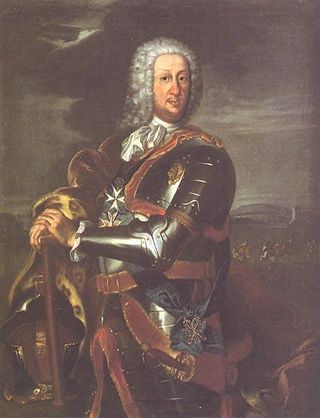
Count Boris Petrovich Sheremetev was an Imperial Russian diplomat and general field marshal during the Great Northern War. He became the first Russian count in 1706. His children included Pyotr Sheremetev and Natalia Sheremeteva.
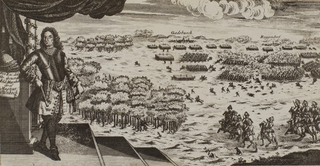
The Battle of Gadebusch or Wakenstädt was Sweden's final great victory in the Great Northern War. It was fought by the Swedes to prevent the loss of the city of Stralsund to Danish and Saxon forces.

A fascine is a rough bundle of brushwood or other material used for strengthening an earthen structure, or making a path across uneven or wet terrain. Typical uses are protecting the banks of streams from erosion, covering marshland, or providing ground improvement in a manner similar to that of modern geotextiles.
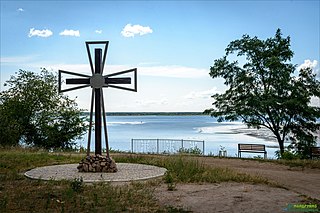
Perevolochna is a former fortress and town in the Polish–Lithuanian Commonwealth and Cossack Hetmanate, and later a village in Poltava Oblast. Before the establishment of Kamianske Water Reservoir in the 1960s, here also existed a river crossing. The settlement was situated at the bank of the Dnieper near the mouth of Vorskla River, where a ford across Dnieper enabled people to cross the river, hence its name. The crossing Perevolochna – Mishuryn Rih was also a key crossing during the Battle of the Dnieper in October 1943.
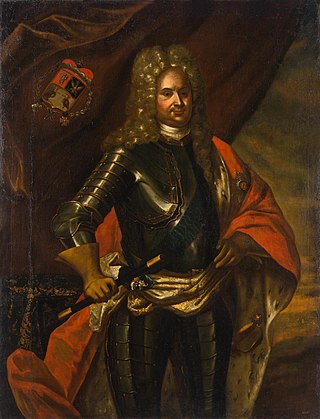
Prince Anikita Ivanovich Repnin was a prominent Russian general during the Great Northern War who superintended the taking of Riga in 1710 and served as the Governor of Livonia from 1719 until his death.

The military history of the Russian Empire encompasses the history of armed conflict in which the Russian Empire participated. This history stretches from its creation in 1721 by Peter the Great, until the Russian Revolution (1917), which led to the establishment of the Soviet Union. Much of the related events involve the Imperial Russian Army, Imperial Russian Navy, and from the early twentieth century, the Imperial Russian Air Service.

Count Carl Gustav Rehnskiöld was a Swedish Field Marshal (fältmarskalk) and Royal Councillor. He was mentor and chief military advisor to King Charles XII of Sweden, and served as deputy commander-in-chief of the Carolean Army, an army he assisted both in its education and development.

The Crossing of the Düna took place during the Great Northern War on July 19, 1701 near the city of Riga, present-day Latvia. The Swedish king Charles XII was in hot pursuit of king Augustus II the Strong of the Polish–Lithuanian Commonwealth and Saxony. The crossing was easily made, and the coalition troops were quickly broken and retreated.

The Battle of Grodno (1706) refers to the battle during the Great Northern War. Grodno was a city of the Polish–Lithuanian Commonwealth at this time.
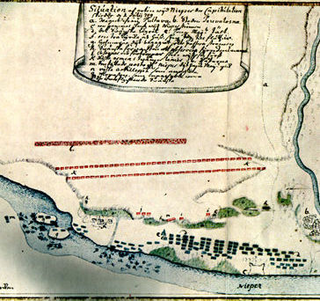
The surrender at Perevolochna was the capitulation of almost the entire Swedish army on 30 June 1709 (O.S.) / 1 July 1709 / 11 July 1709 (N.S.). It signified the virtual annihilation of the once formidable Swedish army after the defeat at Battle of Poltava, and paved the way for the eventual Russian victory in the Great Northern War. After the Battle of Poltava, Charles XII escaped to Moldavia, a vassal state of the Ottoman Empire.

The siege of Viborg took place in the spring of 1710 during the Great Northern War (1700–1721), as a second attempt by the Russians to capture the fortress port of Viborg, near the modern border between Russia and Finland, after a failed attempt in 1706. After the outbreak of the war, Swedish forces had fortified themselves in the port of Viborg. In order to assure safety for the newly founded city of Saint Petersburg, Peter the Great ordered the Swedish fort to be secured. A first unsuccessful attempt was made in 1706. Later plans were put on hold because of other ongoing conflicts but, after the Russian success at the Battle of Poltava in June 1709, the men and resources were available to capture the town.

The Battle of Krasnokutsk–Gorodnoye took place on February 20–22, 1709, in the Swedish campaign of Russia during the Great Northern War. The Swedish troops were directly led by Charles XII King of Sweden who pursued a force of Russians commanded by Otto Rudolf von der Schaumburg from the minor battle of Krasnokutsk to the town Gorodnoye where a new battle took place, with the Russians now commanded by Karl Evald von Rönne. The Swedes were victorious but cancelled their offensive when the night fell.
The Battle of the Neva took place on September 9, 1708 during the Swedish invasion of Russia in the Great Northern War. While Charles XII had started his offensive against Russia from his winter quarters in Saxony, the Swedish–Finnish army of 12,000 men under the command of Georg Lybecker went in field to interrupt and possibly capture the newly-established ports and town of Saint Peterburg, which had been built on Swedish land. This was intended to draw the attention and troops from the main Russian army facing Charles. The Russian forces stationed in Ingria consisted of 24,500 men of which the command had been appointed to Fyodor Apraksin. While having reached the river of Neva the Swedes under Lybecker prepared their crossing. Apraksin had fortified the opposite bank with about 8,000 men and several boats patrolling the river.
Carl Ewald von Rönne was a German-born Russian cavalry officer. He became General of the Cavalry in the Russian army of Peter the Great. He served in both the Great Northern War and in the Russo-Turkish War (1710–11). He alo commanded the tsarist army in Ukraine from 1711 to 1716.

The Drabant Corps of Charles XII was the most prestigious unit in the Swedish Army during the time of the Great Northern War. As a result of the reforms of 1700, all personnel in the corps received an officer's rank with increased wages, while its size was eventually set at 168 men. Those serving as Drabants were almost exclusively recruited from the Swedish Empire, with most coming from Sweden. The corps was issued the finest weapons, horses, and clothing was often adorned with gold lacing. They fought according to the cavalry regulations of the Caroleans, emphasizing the cold-steel charge in slight wedge formations, knee behind knee, over the more common caracole. This strategy allowed them to function as a bodyguard for the king as well as an elite combat unit, often playing a crucial role in the battles despite their relatively small size. During the war, the corps frequently marched with the main army and the king, fighting in most battles.
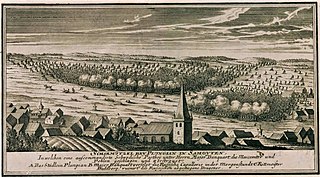
The Battle of Palanga, or the Battle of Polangen, was fought on 13 February 1705 between a Swedish army commanded by Joachim Danckwardt and a Russian–Lithuanian army under Iwan Stephan Gogaron Morbirun. Danckwardt was sent to Palanga in Samogitia with 387 cavalry to reopen the line of communication between Courland and eastern Prussia, in which he was successful. The Russians and Lithuanians gathered a force of about 2,000 cavalry and intercepted him at Palanga. Danckwardt was able to fend off their attacks for a while, before winning the battle with a counterattack against their lines. The Swedish detachment then participated in Lewenhaupt's short-lived offensive in Samogitia. At the Battle of Gemauerthof later that year, Danckwardt was killed in action.




















